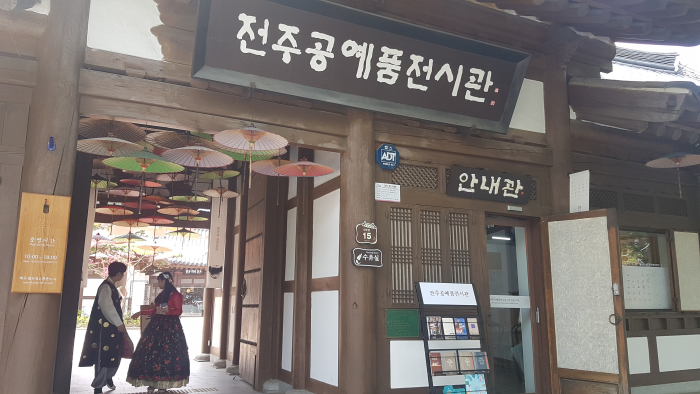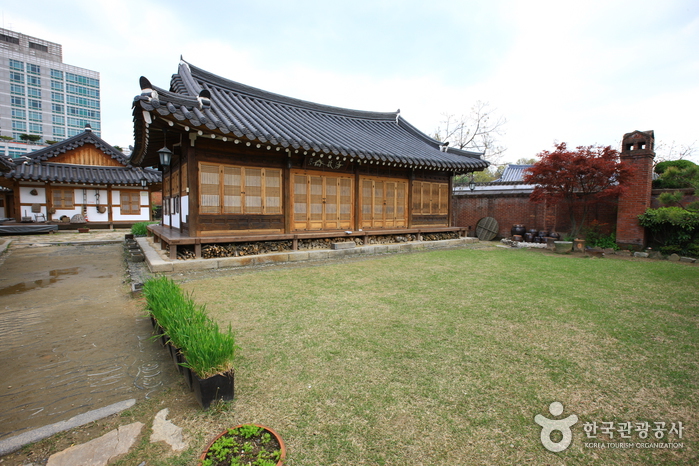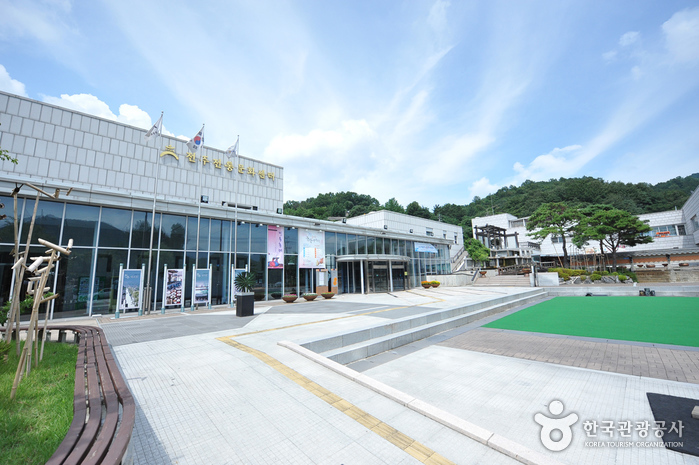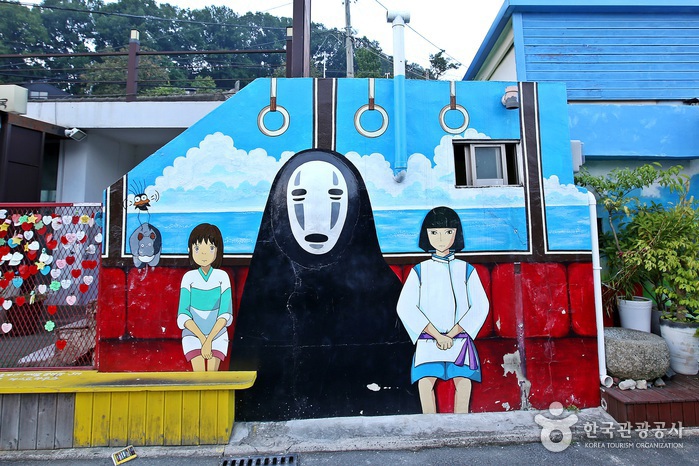Centre d'exposition de l’artisanat traditionnel de Jeonju (전주공예품전시관 전주명품관)
1.7Km 2024-04-07
15, Taejo-ro, Wansan-gu, Jeonju-si, Région Jeonbuk
+82-63-282-8886
Le centre d’exposition de l’artisanat traditionnel de Jeonju permet non seulement aux visiteurs de découvrir la beauté de l’artisanat traditionnel coréen, mais aussi de créer leurs propres créations. Le centre abrite un hall d’exposition, un hall spécial et un hall pour les activités. C’est dans le hall des activités que les visiteurs peuvent créer leurs propres pièces : feuilles de papier de riz, poterie, meunuiserie, broderie etc. Par ailleurs, dans le magasin d’artisanat il est possible d’acheter des pièces faites par des professionnels.
Dan Kyung [Korea Quality] / 단경 [한국관광 품질인증]
1.7Km 2024-04-07
99, Hanji-gil, Wansan-gu, Jeonju-si, Région Jeonbuk
+82-10-5304-4380
Beginning of brightness that is what Hanok Guesthouse Dankyung means. The name reflects the politeness and consideration of the people of Jeonju. It also carries the wish for the guests of the guesthouse to become polite and considerate as well.
Since it was built in June 1943, Dankyung has kept its original form intact through the turbulent period of Korea's liberation from Japanese colonization, Korean War, and modernization. Despite the traditional form, the approximately 70-year-old Hanok is convenient to use and is beautiful in shape, emitting its beauty and gracefulness to the visitors of Jeonju Hanok Village. Anyone staying in Dankyung will feel as if he/she has become a noble man/woman of old Korea.
The white birch garden at the entrance, maple tree, and apricot flower tree in the yard create a seasonal atmosphere. Dansil, Hyangsil, and Gyeongsil of the main building and Byeolsil and Dasil of the separate building are equipped with a wooden floor, giving off a delicate wood scent. The gallery opposite the garden displays artworks and provides a space for guests to have breakfast or drink coffee or tea. The rooftop of the gallery is a special place for guests so that they can enjoy an uninterrupted view of Jeonju Hanok Village over drinks.
Bukyungdang [Korea Quality] / 부경당 [한국관광 품질인증]
1.7Km 2024-04-07
99-5, Hanji-gil, Wansan-gu, Jeonju-si, Région Jeonbuk
+82-10-5327-8736
Located at the heart of the Jeongju Hanok Village, Bugyeongdang is a beautiful traditional 60-year old Hanok.
Traditional floor, roof tiles, and jar stands next to stone walls, while small garden and flower beds reflect the architect couple's attentive hands. As a Hanok with one of the prettiest gardens in Jeonju Hanok Village, it is a good place to appreciate the garden flowers and enjoy the unique laid-back atmosphere of Hanok while sitting on the floor. The place is close to major tourist attractions including Imokdae, Gyeonggijeon, Jeondong Catholic Cathedral, and Hyanggyo.
The owner, who was born and raised in the Jeonju Hanok Village, describes must-go sites like a tour guide and introduces undiscovered great restaurants or things-to-do to the guests. As the owner, who had long been engaged in architecture, takes care of the Hanok, the building always stays clean and in good condition.
In the shared kitchenette, guests can prepare simple breakfast for themselves with the dishes and cups made by the wife of the owner herself. Luggage storage services before check-in and after check-out, and description of tourist attractions are provided.
Dongnagwon (동락원)
1.7Km 2024-04-07
33-6, Eunhaeng-ro, Wansan-gu, Jeonju-si, Région Jeonbuk
+82-63-285-3490
La maison Dongnagwon est une bâtisse représentative du village de Hanok de Jeonju, offrant l’opportunité d’effectuer un ‘Hanok Stay’ (passer la nuit dans une maison traditionnelle coréenne) et de vivre la vie coréenne traditionnelle. Affiliée au collège Kijeon de Jeonju, Dongnagwo est aussi un lieu de commémoration à la mémoire de W. M. Junkin, venu en Corée en 1892 en tant que missionnaire, et originaire de l’église presbytérienne du sud des Etats-Unis. Dongnagwon est une structure hanok traditionnelle consistant en un Anchae (bâtiment principal), Sarangchae (maison détachée) et Haengnangcha (maison des domestiques). Elle représente parfaitement l’agencement des vieilles maisons hanok de Jeonju à l’époque où W. M. Junkin effectuait ses travaux religieux dans la région. Les visiteurs de Dongnagwon ont la possibilité de s’essayer à la vie traditionnelle coréenne en passant une nuit dans une chambre du hanok, mais également en découvrant la musique traditionnelle, l’artisanat local et la dance. De plus, Dongnagwon propose également l’hébergement de groupes ou l’accueil lors de l’organisation de conférences, séminaires et évènements familiaux. Pour les groupes supérieurs à 30 personnes, il est possible de louer le site entier (couvrant toutes les zones du site, incluant Seungdokdang, Seunghwadang, Cheongyuje, et le jardin de devant).
Blueboat guest house Jeonju [Korea Quality] / 블루보트게스트하우스 전주점 [한국관광 품질인증]
1.7Km 2024-04-07
2nd floor, 75, Chunggyeong-ro, Wansan-gu, Jeonju-si, Région Jeonbuk
+82-10-6545-9049
'Blueboat Hostel Jeonju is one of guesthouses of the 'The Guest House' chain in Busan, Seoul, and Gyeongju. Blueboat Hostel Jeonju opened in April 2016 in Gyeongwon-dong, Jeonju-si, which is only 10 minutes away from Gyeonggijeon Shrine on foot. A number of other popular tourist destinations including Jeonju Hanok Village, Jeongdong Cathedral, and Nammun Market are also within walking distance. The hostel has seven guestrooms furnished with steel frame beds. The bathrooms and kitchen are shared among the guests, and there is a television in the kitchen. The rooms have a trendy interior design because it's mostly visited by young tourists. The guesthouse is just like one of those you can find in other countries, except cleaner.
Ihwa Gotaek [Korea Quality] / 이화고택 [한국관광 품질인증/Korea Quality]
1.7Km 2024-04-07
91, Hanji-gil, Wansan-gu, Jeonju-si, Région Jeonbuk
This “ㄱ”-shaped hanok (traditional Korean house) building, standing to the right-hand side of the gate, is an old house with a history of more than 120 years that was transplanted to its present site from its original location in Buan’s local Confucian school in Jeollabuk-do. The building to the left across the courtyard is a “ㄷ”-shaped building with a history of about 70 years. The buildings at Ihwa Gotaek stick to the classics of hanok architecture, featuring the trio of open wooden-floor spaces called numaru, toenmaru, and jjongmaru.
There are 8 rooms in total, 1 four-person room with eight maximum occupancy, and 7 two-person rooms with maximum occupancy of four. All rooms have their own attached restrooms. Guests are served with complimentary seasonal refreshments, either a sweet rice punch (sikhye) or shaved ice with sweetened red beans (pat bingsu) made in-house, and for breakfast guests have a wonderful spread that includes bibimbap, rice cake soup, black sesame porridge, and bean-powder-coated rice cake, served in traditional bronze tableware. Guests can also place their reservations for traditional cultural programs like pansori (epic chant), tea ceremony, natural dye, and Korean paper art, and enjoy a discount of 30% in hanbok (traditional Korean clothes) rental.
Centre de la culture traditionnelle de Jeonju (전주전통문화관)
1.7Km 2023-04-06
20, Jeonjucheondong-ro, Wansan-gu, Jeonju-si, Région Jeonbuk
Le centre de la culture traditionnelle de Jeongju offre aux visiteurs un large panel sur les traditions, ainsi que la possibilité de voir des performances de chants « pansori » ou dances « minyo » traditionnels. Ceci, ouvert au public tout au long de l’année. Dans le hall des restaurants traditionnels il est possible de déguster divers spécialités tel que le bibimpap (riz avec des légumes) un des plats les plus réputés de Jeonju. Par ailleurs, un hall de mariages traditionnels accueillent les cérémonies de mariage.
Bu Yong Heon [Korea Quality] / 부용헌 [한국관광 품질인증]
1.7Km 2024-04-07
149-3, Hyanggyo-gil, Wansan-gu, Jeonju-si, Région Jeonbuk
+82-10-8646-0964
Buyongheon is located in Jeonju Hanok Village. Precisely speaking, Buyongheon is the very next door to Jeonju Hyanggyo (Confucian Temple and School). Across the alley are Jeonju Hyanggyo Culture Center and Wanpanbon Culture Center. If you walk a few more steps, you will reach Jeonju Hanbyeok Culture Center where you can see various performances and experience the culture and foods of Jeonju. Omokdae can be seen from the garden of Buyongheon. Across the Jeonjucheon Stream is the National Intangible Heritage Center.
The beginning of Buyongheon is deeply related with Jeonju Hyanggyo. In around 1935, the local bureaucrats lived around the Hyanggyo after building 12 houses one after another. Most of them came from rich families. These collective houses were called Buyong Houses, which meant rich houses. The name Buyongheon originated from Buyong Houses. The rooms of Buyongheon are composed of Toenmaru Bang, Daecheong Maru Bang, Large Daecheong Maru Bang and Big Sarangchae. The interior of the rooms looks neat with the beauty of blank space as they excluded unnecessary decorations. Carefully prepared breakfast is served upon request made in advance. Visitors can also experience traditional culture such as traditional etiquette education and Korean paper art.
In fall, the yellow leaves of the ginkgo tree in the garden of Jeonju Hyanggyo lights up the roof of Buyongheon. It is recommendable to walk along the Jeonjucheon Stream and take pictures of the colorful murals and the cafes in the Jaman Mural Village located on the left sie of the Hanok Village. It takes 15 minutes from Jeonju Station and 10 minutes from Jeonjuu Express Bus Terminal to Buyongheon by taxi.
Le village des peintures murales Jaman (자만마을 벽화갤러리)
1.7Km 2024-07-09
Gyodong, Wansan-gu, Jeonju-si, Jeonbuk
Le village des peintures murales Jaman se situe près du village des hanok de Jeonju. Le village a été construit par des réfugiés de la guerre de Corée. Le village a été aménagé avec des peintures murales dans les années 2010. Plusieurs des maisons sur place ont été transformées en cafés, guesthouse et restaurants.
Village des peintures murales de Jaman (자만벽화마을 - 외국어사이트용)
1.7Km 2024-04-07
1-10, Jamandong 1-gil, Wansan-gu, Jeonju-si, Région Jeonbuk
Le village des peintures murales de Jaman est un petit village situé en face du village hanok de Jeonju, sur la colline d’une montagne. On peut trouver des maisons alignées les unes aux autres sur les pentes du village, sur les murs on trouve des peintures de toutes les couleurs.

![Dan Kyung [Korea Quality] / 단경 [한국관광 품질인증]](http://tong.visitkorea.or.kr/cms/resource/65/2593265_image2_1.jpg)
![Bukyungdang [Korea Quality] / 부경당 [한국관광 품질인증]](http://tong.visitkorea.or.kr/cms/resource/29/2593529_image2_1.jpg)

![Ihwa Gotaek [Korea Quality] / 이화고택 [한국관광 품질인증/Korea Quality]](http://tong.visitkorea.or.kr/cms/resource/50/2707550_image2_1.jpg)

![Bu Yong Heon [Korea Quality] / 부용헌 [한국관광 품질인증]](http://tong.visitkorea.or.kr/cms/resource/94/2596794_image2_1.jpg)


 Français
Français
 한국어
한국어 English
English 日本語
日本語 中文(简体)
中文(简体) Deutsch
Deutsch Español
Español Русский
Русский